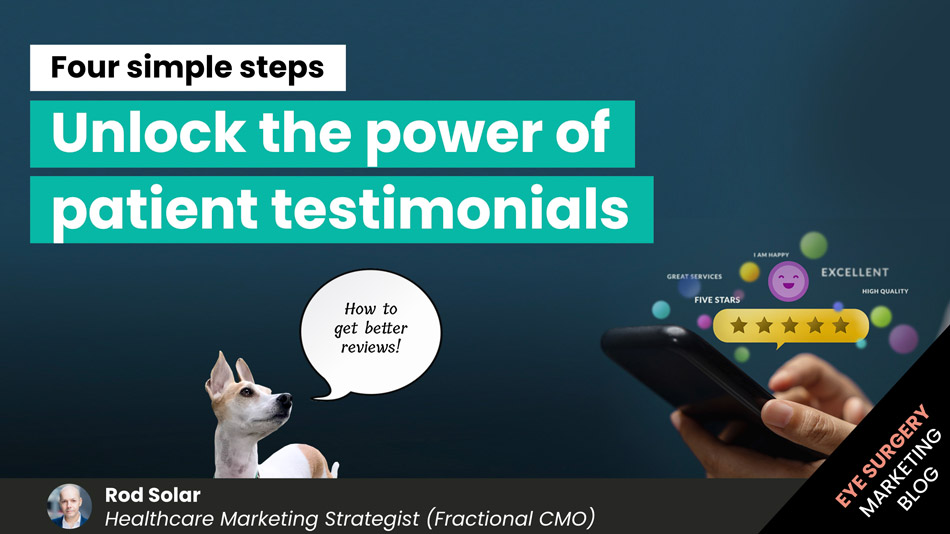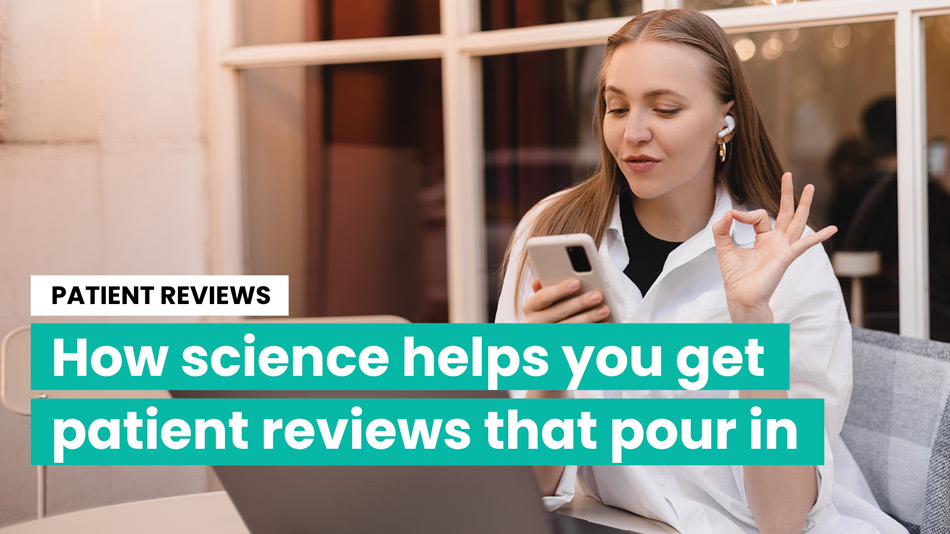
Unlock the power of patient testimonials
Four simple steps to get outstanding reviews from patients
Four steps to get the most out of this valuable marketing tool.
If you’re like most refractive surgeons, you put a lot of thought into your patient testimonials. You want to ensure that they reflect positively on your skills and practice, but what if there were ways to get even more out of these testimonials? This article describes four steps you can take to get more mileage from patient feedback.
STEP 1: Source your testimonials and reviews
Patient testimonials can be an asset for any healthcare practice. Patient referrals are one of the most effective forms of marketing and can be used across various marketing channels. If you are starting from the ground up, with patient testimonials, the following tactics can help.
- Request a testimonial and/or review from every patient. This task can be streamlined if your practice uses practice management software that features automated patient communications. We suggest sending to every patient an automated SMS text message with a link to your practice’s Google Review page.
- Send patients a follow-up survey after treatment and include a question about their experience. You can promote the survey on your website and social media channels.
- Read every online review. Thank patients who leave positive feedback. Use negative reviews as an opportunity to learn and improve your practice’s delivery of patient care.
- Monitor social media for positive comments from patients about their experiences with your practice.
- File a copy of every thank you letter or card you receive from a patient. You can retrieve them for later use.
- Leave a notebook in your office reception area where patients can write testimonials.
Getting testimonials can be challenging for many practices—not because patients are unwilling, but because surgeons and staff are uncomfortable making the request. In our experience, negative reviews are outliers. The more often you request reviews, the more excellent testimonials you’ll receive. See the accompanying sidebars for best practices on soliciting patient reviews and responding to them online.
Best practices for soliciting patient reviews
- Check the rules in your country to determine how you can use patient testimonials in your practice development. Read the regulations carefully. For example, health practitioners in Australia are permitted to use patient testimonials, but not if they include protected health information such as symptoms or treatments.
- Obtain written consent to communicate with your patients by phone, email, and SMS text message at the earliest opportunity (registration).
- Seek consent to use patients’ testimonials in your marketing efforts before their treatment. Leaving positive comments on your social media properties does not constitute consent.
- Do not request Yelp reviews because it is against their policy.
- Do not incentivize patients to leave a review. This includes non-monetary incentives such as promising to plant a tree in exchange for a review.
- Do not gate your reviews. Gating is when a business encourages only happy customers to leave a review or displays only positive reviews on its assets. This practice has been in violation of Google’s regulations since 2018. Violating these guidelines could result in your Google Business profile being shut down.
- Disallow review swapping and trading. Google strictly forbids this practice. Only people who were customers of the product or service may leave reviews. Violating these guidelines could result in your Google Business profile being shut down.
- Discourage current and former employees and independent contractors representing the practice from leaving reviews.
- Use caution with bulk review requests. They may raise red flags with Google’s algorithm because it looks for unusual activity patterns on Google Business profiles. Ten reviews in 1 day on an ophthalmology practice’s profile that averages one review every 6 months could trigger suspicion.
NOTE: The best way to answer that nagging question about practice growth or marketing or patient volume in the back of your mind is to book a free 15-minute compatibility call. Get some options and go away with a clear idea of what’s possible.
Best practices for responding to patient reviews online
- Thank patients for their feedback. Patient comments in online reviews and social posts can expose operational problems or help you train your staff. Show appreciation for all feedback—good or bad.
- Keep responses anonymous by not acknowledging that the patient is or is not your patient or revealing or confirming any personal information about the reviewer, even if they shared it in their review. When responding to what you might do to remedy a situation or to explain why you acted in a certain way, rRefer only to practice policy, not individual circumstances.
- Preserve patient privacy. In your response, never acknowledge that a reviewer is or was a patient.
- Develop prewritten response templates for your team to use in different review scenarios. Work with your legal and compliance team to develop 15 to 20 approved responses to common patient scenarios.
- Do not delete reviews. The exception is a negative review that includes profanity or slander. Otherwise, it can raise suspicion if all your reviews are positive.
- Never alter review content when you repurpose it and don’t acknowledge or repeat protected health information (PHI). If a review from a patient on a third-party platform that you do not control includes PHI, you don’t need to delete it. Do not, however, repeat or disclose additional PHI in your response, on social media, or on your website.
STEP 2: Dive Deeper
Once you begin receiving patient testimonials, you can turn them into content. Most patient reviews are not initially detailed enough for repurposing, so an effort to get more information is usually required. If you ask nothing else, ask patients to write about how they felt before receiving treatment at your practice and how they felt afterward. The goal of diving deeper is to help your patients tell engaging and emotional stories about their experiences with your practice. Think of the people who will read testimonials as shoppers trying on clothes—they want to see how your practice fits them before making a commitment.
Our advice is to start by requesting a video conference with someone who left a positive review to learn more about their story. The following questions are an excellent place to start when you meet with them:
- What treatment did you undergo?
- What is the problem you had before you had [insert treatment]?
- Describe your frustration when trying to solve that problem by other means before undergoing [insert treatment] at our practice.
- How long did you think about whether to undergo [insert treatment]?
- What stands out as different about your experience with our practice?
- What surprised you during your patient journey with us?
- Please tell me about the moment you realized [insert treatment] was working to solve your problem.
- Please describe your life now that your problem has been solved or is being solved.
- What advice do you have for anyone considering the same treatment? Should they be anxious or nervous?
STEP 3: Build content
Determine the medium through which you will share your patient testimonials and the platform you will leverage to amplify the message. The information you obtain by interviewing patients can be used to craft a case study testimonial that can be shared on your practice’s website. Remember to focus on the patient and their story rather than you and your service.
STEP 4: Splinter content
You can splinter testimonials into additional formats and diversify the channels through which you can share them. For example, you could record and edit a patient’s virtual interview into a video testimonial that can be shared on social media, sent to your email list, and edited for use in Facebook and Instagram ads. You could also invite the patient to be a guest on your podcast for a progress interview after at least 1 year elapses after treatment.
Start today
Testimonials often inspire other patients to comment on their own experiences with your practice. In this way, testimonials can be self-perpetuating. Dig deeper with those who comment, and they could become the subject of your next testimonial. Following these four steps to establish a self-perpetuating cycle of patient testimonials in your practice can help you put your best foot forward online and offline.
About the author

Rod Solar
Founder & Scalable Business Advisor / fCMO
Rod Solar is a co-founder of LiveseySolar and a Scalable Business Advisor for its customers. Rod mentors and coaches eye surgery business CEOs/Founders and their leadership teams to triple their sales, double their profit, and achieve their “ideal exit”.
Related Posts
Meet our Co-Founders
We’re passionate about helping leaders of high-quality, growth-minded practice owners double their practice revenue

Rod Solar
Founder & Scalable Business Advisor
For over 20 years, I’ve helped ophthalmology entrepreneurs scale their private practices. I specialise in doubling revenue within three years by offering a proven framework, hands-on experience, and a team of experts who implement what works. We take the guesswork out of growth and scale, so you can focus on delivering exceptional patient care while maximising the value of your business.
LiveseySolar completely transformed the way we were approaching this… We’ve gone from having just the dream of having a practice to having a practice up and running with people making inquiries and booking for procedures… It’s extremely pleasing. We feel lucky we connected with LiveseySolar.
— Dr Matthew Russell, MBChB, FRANZCO, specialist ophthalmic surgeon and founder of VSON and OKKO

Laura Livesey
Founder & CEO
I’m the co-founder & CEO of LiveseySolar. I’ve developed powerful eye surgery marketing systems that increase patient volumes and profits for doctors, clinics, and hospitals, since 1997.
Rod and Laura know as much about marketing surgery to patients as I know about performing it. They are an expert in the field of laser eye surgery marketing. They know this industry inside out. I believe that they could help many companies in a variety of areas including marketing materials, sales training and marketing support for doctors.
— Prof. Dan Reinstein, MD MA FRSC DABO, founder of the London Vision Clinic, UK











